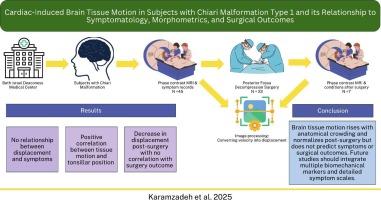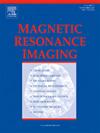Cardiac-induced brain tissue motion in Chiari Malformation type 1 subjects and its relationship to symptomatology, morphometrics, and surgical outcomes
IF 2
4区 医学
Q2 RADIOLOGY, NUCLEAR MEDICINE & MEDICAL IMAGING
引用次数: 0
Abstract
Purpose
To determine whether cardiac-induced brain-tissue displacement in Chiari Malformation type 1 (CMI) relates to patient symptoms, morphometrics, and surgical outcomes.
Methods
We performed cardiac-gated phase-contrast MRI in 45 adults with CMI, converting velocity measurements to voxel-wise displacement in the cerebellum, pons, medulla, and cervical cord. We examined if displacement was correlated with each symptoms of subjects, and two anatomic measurements: tonsillar position (TP) and the ratio of neural-tissue area at foramen magnum to the area of foramen magnum. In seven patients who underwent posterior fossa decompression (PFD), we compared pre- versus post-operative displacement in seven paired scans and related changes to the Chicago Chiari Outcome Scale (CCOS).
Results
No significant correlations were found between displacement and symptom reports. TP correlated moderately with displacement (r = 0.47–0.61, p < 0.002), and ratio of neural-tissue area showed modest links to cerebellar motion (r = 0.34–0.36, p < 0.02). After PFD, mean and peak cerebellar displacement decreased by 45 % and 60 %, respectively (p < 0.05), but neither pre-operative motion nor its reduction predicted CCOS scores.
Conclusion
While displacement increases with anatomical crowding and normalizes after surgery, it does not predict clinical symptoms or surgical outcomes. Future work should combine multiple biomechanical markers and detailed symptom scales in an effort to develop a multidimensional biomarker for guiding treatment and assessing recovery in CMI.

1型Chiari畸形患者心脏诱导的脑组织运动及其与症状学、形态计量学和手术结果的关系
目的探讨1型Chiari畸形(CMI)心源性脑组织移位是否与患者症状、形态计量学和手术结果相关。方法:我们对45名成年CMI患者进行了心门控相位对比MRI检查,将速度测量转换为小脑、脑桥、髓质和颈髓的体素位移。我们检查了位移是否与受试者的每一种症状相关,以及两项解剖学测量:扁桃体位置(TP)和枕骨大孔神经组织面积与枕骨大孔面积的比值。在7名接受后颅窝减压(PFD)的患者中,我们通过7次配对扫描比较了术前和术后移位以及芝加哥Chiari结果量表(CCOS)的相关变化。结果移位与症状报告无显著相关性。TP与位移适度相关(r = 0.47-0.61, p < 0.002),神经组织面积比与小脑运动适度相关(r = 0.34-0.36, p < 0.02)。PFD后,平均和峰值小脑位移分别下降45%和60% (p < 0.05),但术前运动和其减少均不能预测CCOS评分。结论移位虽随解剖拥挤而增加,术后恢复正常,但不能预测临床症状或手术结果。未来的工作应结合多种生物力学指标和详细的症状量表,努力开发一个多维的生物标志物来指导治疗和评估CMI的恢复。
本文章由计算机程序翻译,如有差异,请以英文原文为准。
求助全文
约1分钟内获得全文
求助全文
来源期刊

Magnetic resonance imaging
医学-核医学
CiteScore
4.70
自引率
4.00%
发文量
194
审稿时长
83 days
期刊介绍:
Magnetic Resonance Imaging (MRI) is the first international multidisciplinary journal encompassing physical, life, and clinical science investigations as they relate to the development and use of magnetic resonance imaging. MRI is dedicated to both basic research, technological innovation and applications, providing a single forum for communication among radiologists, physicists, chemists, biochemists, biologists, engineers, internists, pathologists, physiologists, computer scientists, and mathematicians.
 求助内容:
求助内容: 应助结果提醒方式:
应助结果提醒方式:


